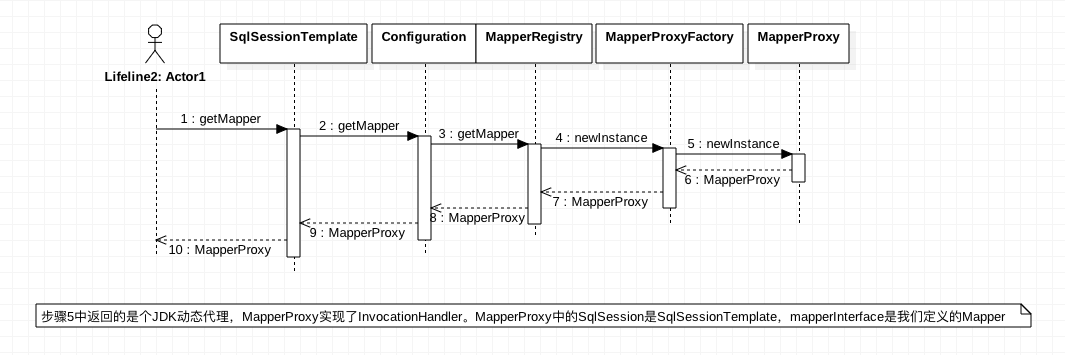From the previous series I, we know that SqlSession is new SqlSessionTemplate(sqlSessionFactory). We start from SqlSessionTemplate analysis.
List-1
public class SqlSessionTemplate implements SqlSession, DisposableBean { private final SqlSessionFactory sqlSessionFactory; private final ExecutorType executorType; private final SqlSession sqlSessionProxy; private final PersistenceExceptionTranslator exceptionTranslator; public SqlSessionTemplate(SqlSessionFactory sqlSessionFactory) { this(sqlSessionFactory, sqlSessionFactory.getConfiguration().getDefaultExecutorType()); } public SqlSessionTemplate(SqlSessionFactory sqlSessionFactory, ExecutorType executorType) { this(sqlSessionFactory, executorType, new MyBatisExceptionTranslator(sqlSessionFactory.getConfiguration().getEnvironment().getDataSource(), true)); } public SqlSessionTemplate(SqlSessionFactory sqlSessionFactory, ExecutorType executorType, PersistenceExceptionTranslator exceptionTranslator) { Assert.notNull(sqlSessionFactory, "Property 'sqlSessionFactory' is required"); Assert.notNull(executorType, "Property 'executorType' is required"); this.sqlSessionFactory = sqlSessionFactory; this.executorType = executorType; this.exceptionTranslator = exceptionTranslator; this.sqlSessionProxy = (SqlSession)Proxy.newProxyInstance(SqlSessionFactory.class.getClassLoader(), new Class[]{SqlSession.class}, new SqlSessionTemplate.SqlSessionInterceptor()); } ...
As shown in List-1 above, it is the construction method of SqlSessionTemplate. The executorType defaults to SIMPLE, which will be mentioned later.
To get Mapper, what is returned at the bottom? As shown in Figure 1 below, the dynamic proxy MapperProxy of JDK is returned. You can see the source code of this class, which implements the InvocationHandler of JDK.

Figure 1
When we call Mapper's method, we call MapperProxy's invoke method. As follows, according to the method we call, we construct a MapperMethod, cache it, and then execute MapperMethod's execute method:
List-2
public class MapperProxy<T> implements InvocationHandler, Serializable { private static final long serialVersionUID = -6424540398559729838L; private final SqlSession sqlSession; private final Class<T> mapperInterface; private final Map<Method, MapperMethod> methodCache; public MapperProxy(SqlSession sqlSession, Class<T> mapperInterface, Map<Method, MapperMethod> methodCache) { this.sqlSession = sqlSession; this.mapperInterface = mapperInterface; this.methodCache = methodCache; } @Override public Object invoke(Object proxy, Method method, Object[] args) throws Throwable { try { if (Object.class.equals(method.getDeclaringClass())) { return method.invoke(this, args); } else if (isDefaultMethod(method)) { return invokeDefaultMethod(proxy, method, args); } } catch (Throwable t) { throw ExceptionUtil.unwrapThrowable(t); } final MapperMethod mapperMethod = cachedMapperMethod(method); return mapperMethod.execute(sqlSession, args); } private MapperMethod cachedMapperMethod(Method method) { MapperMethod mapperMethod = methodCache.get(method); if (mapperMethod == null) { mapperMethod = new MapperMethod(mapperInterface, method, sqlSession.getConfiguration()); methodCache.put(method, mapperMethod); } return mapperMethod; } ...
The SqlSession passed in from the execute method of MapperMethod is SqlSessionTemplate. There are many contents in the execute method. See the following articles.